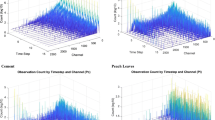Abstract
The Spectral Deconvolution Analysis Tool (SDAT) software was developed to improve counting statistics and detection limits for nuclear explosion radionuclide measurements. SDAT utilizes spectral deconvolution spectroscopy techniques and can analyze both β-γ coincidence spectra for radioxenon isotopes and high-resolution HPGe spectra from aerosol monitors. Spectral deconvolution spectroscopy is an analysis method that utilizes the entire signal deposited in a gamma-ray detector rather than the small portion of the signal that is present in one gamma-ray peak. This method shows promise to improve detection limits over classical gamma-ray spectroscopy analytical techniques; however, this hypothesis has not been tested. To address this issue, we performed three tests to compare the detection ability and variance of SDAT results to those of commercial-off-the-shelf (COTS) software which utilizes a standard peak search algorithm.
Similar content being viewed by others
References
K. M. Foltz Biegalski, S. R. Biegalski, J. Radioanal. Nucl. Chem., 1 (2005) 259.
T. W. Bowyer, Xe Radionuclides, Atmospheric: Monitoring, in: Encyclopedia of Environmental Analysis and Remediation, R. A. Meyers (Ed.), John Wiley & Sons, Inc., 1998.
K. M. Foltz Biegalski, J. Radioanal. Nucl. Chem., 3 (2001) 663.
T. H. Prettyman, R. A. Cole, R. J. Estep, G. A. Sheppard, Nucl. Instr. Meth. Phys. Res., A356 (1995) 470.
D. A. Haas, S. R. Biegalski, K. M. Foltz Biegalski, J. Radioanal. Nucl. Chem., 276 (2008) 000.
C. L. Lawson, R. J. Hanson, Solving Least Squares Problems, Englewood Cliffs, N.J., Prentice-Hall, 1974.
K. M. Foltz Biegalski, J. Radioanal. Nucl. Chem., 3 (2001) 673.
G. Knoll, Radiation Detection and Measurement, 2nd ed., John Wiley & Sons, New York, 1989, p. 658.
L. A. Currie, Anal. Chem., 40 (1968) 586.
Author information
Authors and Affiliations
Corresponding author
Rights and permissions
About this article
Cite this article
Foltz Biegalski, K.M., Biegalski, S.R. & Haas, D.A. Performance evaluation of spectral deconvolution analysis tool (SDAT) software used for nuclear explosion radionuclide measurements. J Radioanal Nucl Chem 276, 407–413 (2008). https://doi.org/10.1007/s10967-008-0519-8
Received:
Published:
Issue Date:
DOI: https://doi.org/10.1007/s10967-008-0519-8




